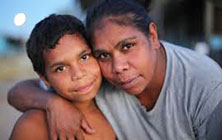|
|
|
|
In My Blood It Runs
|
 |
|
Maya Newell’s observational documentary In My Blood It Runs is about 10-year-old
Dujuan Hoosan: a spirited but, in many respects, ordinary, typical Aboriginal
boy living in the Northern Territory of Australia. He’s at a crucial
transitional point in his existence, poised between distinct white and black
cultures, and coming to consciousness about the significance of that situation.
The film looks into his unfolding life by following him for a circumscribed
period of time.
Dujuan lives with his family in Hidden Valley, Alice
Springs. He’s clearly a very smart kid, and possesses a gift of healing that we
observe him often expertly using. But he’s also constantly in trouble at school.
From the glimpses of classroom practice that we get, it’s little wonder that
Dujuan is irritated and bored out of his brain.
His white teachers (it is astonishing that they let
themselves be included in the final cut of the doco) impart lessons about
Captain Cook and the settlement of Australia with scarcely a flicker of ethical
responsibility; they mention the Dreaming and Aboriginal spirits, but almost
seem to be mocking it as irrational superstition. Even when, two-thirds of the
way into the film, Dujuan is moved into the supposedly more congenial learning
environment of the Yipirinya school, this tense, intercultural situation seems
not to improve much.
Dujuan prefers, as he tells us, to be free. To the
chagrin of his family, that can mean simply wandering off down the road when he
feels like it, or mucking around with older mates in a parking lot. But, more
profoundly, it refers to his soulful desire to return, as often as possible, to
his homeland in Sandy Bore.
It is there that Dujuan learns his indigenous
language, is told the traditional tales – and where he really starts to develop
a sharp political conscience. Late in the film, in a surprising development,
Dujuan will travel again, elsewhere – to Spring Creek, to spend time with his
father.
Like a number of other people we see in In My Blood It Runs, Dujuan receives a
special credit for his creative collaboration on the project. And indeed, he
not only shot some of the digital footage used, but also proudly declares at
one point: “This movie is about me” – so nobody’s going to stop him declaring
his passionate beliefs about fairness, justice and dignity for his people. At
this level, it is unquestionably a stirring and well-pitched movie.
I was less enamoured of its overall style. To organise
her material, Newell uses some structuring devices that are conventional in
non-fictional reportage – such as an intermittent stream of radio or TV news
voices, punctuating the flow of everyday life and filling in developments from the
larger social context. She also creates a welcome space for almost Terrence
Malick-like, contemplative, poetic insertions of shots following Dujuan from
close behind and in slow motion: a lyrical celebration of dwelling within
nature. Even the archival clips are bathed in flares of light to signal their
old-fashioned, unprogressive ideology. These effects sometimes register as a
bit corny.
At the highest pitch of this stylisation, however,
Benjamin Speed’s musical score builds to a crescendo only to cut out at the
moment when Dujuan reaches his ultimate howl directed at white Australia: “Stop
killing Aboriginal people!”
© Adrian Martin June 2019 |
![]()